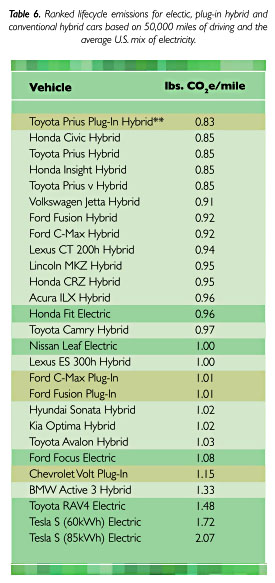Climate Central has some bad news for all of us eco-sensitive folks: figuring out the best car to drive is harder than you think. For starters, you need to take into account which state you live in. If you live in, say, Washington or Vermont, where most of your electricity comes from hydropower or nuclear, an electric car is pretty carbon friendly. If you live in Kentucky, where your power mostly comes from coal, an electric car isn’t such a good choice.
But there’s more. You also need to account for the carbon emissions it takes to build the car in the first place. And since battery manufacturing is pretty carbon intensive, a car with a big  battery starts out with a big carbon deficit to make up. Their conclusion:
battery starts out with a big carbon deficit to make up. Their conclusion:
In 26 states, a plug-in hybrid is the most climate-friendly option (narrowly outperforming all-electrics in 11 states, assuming 50:50 split between between driving on gas and electric for the plug-in hybrids), and in the other 24 states, a gas-powered car the best. All-electrics and plug-in hybrids are best in states with green electrical grids with substantial amounts of hydro, nuclear and wind power that produce essentially no carbon emissions. Conventional hybrids are best in states where electricity comes primarily from coal and natural gas.
The table on the right shows Climate Central’s total lifecycle ranking of various cars based on 50,000 miles of driving and U.S. average electrical emissions. All-electric cars do better if you live in a state with lots of hydropower, and they also do better if you drive more, since that provides more time to make up the carbon deficit from manufacturing the battery.
You can read the whole report for more details, including rankings for each state. In Vermont, the all-electric Honda Fit comes in first. In California, a plug-in Prius is the top choice. In Kentucky, a regular gasoline-powered hybrid Prius is number one. The lovely Tesla S, sadly, does poorly pretty much everywhere.













